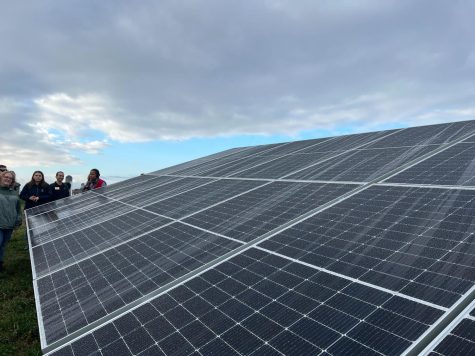Gaucho Solar project to replace 18% of Pitt’s electricity with clean, renewable energy
Pitt’s solar farm under-construction near Pittsburgh International Airport.
November 4, 2022
Pitt and Vesper Energy partnered to create the Gaucho Solar project, which entails building a 68-acre solar farm near the Pittsburgh International Airport.
Aurora Sharrard, Pitt’s executive director of sustainability, said this farm will reduce Pitt’s carbon footprint and is a significant step forward for sustainability globally.
“Electricity consumption at the University, just representative of any organization, represents around 50% of our total greenhouse gas footprint,” Sharrard said. “Cleaning the sources of our electricity and our other energy sources is very important. And so strategies like this partnership with Vesper and otherwise are an important step in that process for what we’re doing at Pitt, but also what organizations and individuals are doing nationally and globally.”
According to Sharrard, the farm will produce 37,500 megawatts of electricity annually, meaning 18% of the Pittsburgh campus electricity will come from the solar farm. A press release from Pitt for the solar farm project said this will reduce greenhouse gas emissions for the University by 15,452 metric tons of carbon dioxide per year. The press release also said this is equivalent to removing 3,330 fuel-burning cars from the roads.

Pennsylvania currently has a diverse energy portfolio, according to David Sanchez, associate professor for the civil and environmental engineering department. He said he is working on diversifying the city of Pittsburgh’s portfolio more specifically.
“We have coal, we have gas, we have nuclear, we have hydroelectric, we have solar. We have wind in the state,” Sanchez said. “So for us, we’re pretty diversified in terms of what we have. There are pros and cons to each one of the production methods for energy, but for Pittsburgh we’re still producing diversity.”
Sharrard said solar is not only a great opportunity to help with this diversification, but also a great way to transition into cleaner and renewable energy sources. According to Sharrard, the addition of renewable sources such as solar are important in reducing carbon emissions.
“Solar is a great opportunity, nationally and globally as we transition our energy sources to cleaner options. And so I think you’re gonna start seeing a lot more solar in Pennsylvania. There’s already a bunch of solar, wind, geothermal and other renewable options cascading out across the US, especially with the encouragement of the federal government and the new inflation Reduction Act,” Sharrard said. “So as we work to decarbonize our energy sources and electrify how we use it, solar is a great portion of that opportunity, and you’re just gonna be seeing more come out over time.”
Sanchez said solar panels produce electricity similarly to photosynthesis in plants.
“The best analogy to give is, if you know about leaves and photosynthesis, same thing. So the leaves, the solar energy that’s embedded in the radiation that comes from the sun, if you were to get sugar out of a sugar cane tree, that conversion to go from the radiation all the way to the sugars, you’re taking 2% of that energy,” Sanchez said. “And in solar panels, that’s like converting 20% into pure electricity.”
Besides producing clean energy, Sanchez said solar panels provide passive and reliable sources of electricity.
“There’s not a lot of maintenance, and they automatically are passively producing,” Sanchez said. “They’re encapsulated. They’re passive. And so it really just gives you some reliable energy production.”
Sanchez said while the Gaucho Solar project will have significant benefits for the University, students and the environment it still has its trade-offs. According to Sanchez, some challenges this and other solar projects face include harming established industries, such as coal or nuclear, along with imposing on the community. He said it’s important to communicate with the community and to be aware of who is affected.
“The challenge of the transition is the fact that a lot of the costs for transitioning are borne by one industry and those who work for that industry. So as we transition, it’s important to be mindful of well, how do we actually also help those communities who do transition or revalidate the way they have contributed to where we are now,” Sanchez said
According to Tanner Whittington, quality manager of the site, the Gaucho Solar project and other solar projects will produce a lot of jobs for the local community.
“It’s just a good opportunity. For this, we hire locally. So it’s a good opportunity to bring people in that may otherwise be looking for work,” Whittington said. “Right now we’re getting close to around 25-30 people on site. Max will probably top out around 65-70.”
Additionally, the press release said the solar farm will maintain a pollinator-friendly landscape. It also said an observation area near the solar farm for University students to use for educational experiences is in the works.
Sharrard said the solar farm is expected to be completed by April of 2023. According to Gary Newton, the site’s construction manager, production of the solar farm is moving fast. Currently, they have installed 5996 posts within a few weeks, with production slowing down due to a supply-chain crisis among solar panel shipments.
“They were really quick. I would say it was less than a month. Probably more like three weeks,” Newton said. “They were moving so fast that the contractor they had hired ordered the solar contractor to move all their stuff out away so the solar contractor could finish putting in the posts.”








